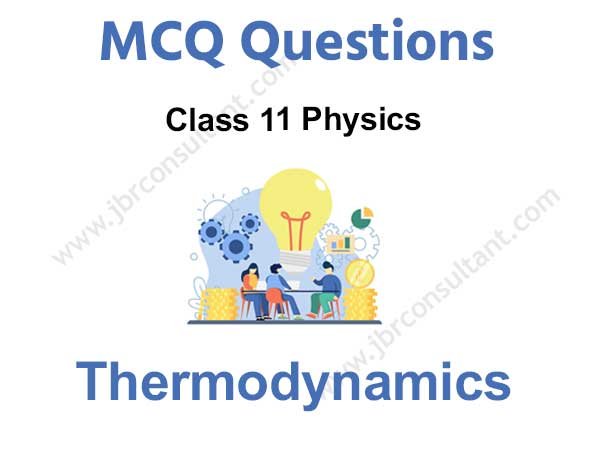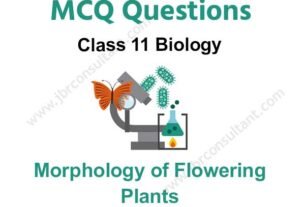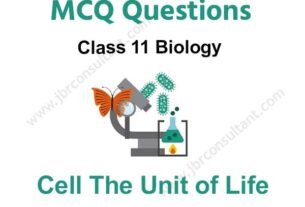Thermodynamics Class 11 MCQ is one of the best strategies to prepare for the CBSE Class 11 Board exam. If you want to complete a grasp concept or work on one’s score, there is no method except constant practice. Students can improve their speed and accuracy by doing more MCQ on Thermodynamics Class 11, which will help them all through their board test.
Thermodynamics Class 11 MCQ Questions with Answer
Class 11 Physics MCQ with answers are given here to Chapter 12 Thermodynamics. These MCQs are based on the latest CBSE board syllabus and relate to the latest Class 11 Physics syllabus. By Solving these Class 11 MCQs, you will be able to analyze all of the concepts quickly in the chapter and get ready for the Class 11 Annual exam.
Learn Class 11 Thermodynamics MCQs with answers pdf free download according to the latest CBSE and NCERT syllabus. Students should prepare for the examination by solving CBSE Class 11 Physics Thermodynamics MCQ with answers given below
Question 1. joule of heat is added to a gaseous system whose internal energy is 40 J, then the amount of external work done is
(a) 150 J
(b) 70 J
(c) 110 J
(d) 40 J
Answer
B
Question 2. A sample of 0.1 g of water at 100°C and normal pressure (1.013 × 105 N m–2) requires 54 cal of heat energy to convert to steam at 100°C. If the volume of the steam produced is 167.1 cc, the change in internal energy of the sample, is
(a) 104.3 J
(b) 208.7 J
(c) 42.2 J
(d) 84.5 J
Answer
B
Question 3. The internal energy change in a system that has absorbed 2 kcal of heat and done 500 J of work is
(a) 6400 J
(b) 5400 J
(c) 7900 J
(d) 8900 J
Answer
C
Question 4. If the ratio of specific heat of a gas at constant pressure to that at constant volume is g, the change in internal energy of a mass of gas, when the volume changes from V to 2V at constant pressure P, is
(a) PV /(γ – 1)
(b) PV
(c) R /(γ – 1)
(d) γPV /(γ – 1)
Answer
A
Question 5. First law of thermodynamics is consequence of conservation of
(a) work
(b) energy
(c) heat
(d) all of these
Answer
B
Question 6. If cp and cv denote the specific heats per unit mass of an ideal gas of molecular weight M, then
(a) cp – cv = R/M2
(b) cp – cv = R
(c) cp – cv = R/M
(d) cp – cv = MR
Answer
C
Question 7. Which of the following is not thermodynamical function ?
(a) Enthalpy
(b) Work done
(c) Gibb’s energy
(d) Internal energy
Answer
B
Question 8. One mole of an ideal gas requires 207 J heat to rise the temperature by 10 K when heated at constant pressure. If the same gas is heated at constant volume to raise the temperature by the same 10 K, the heat required is (Given the gas constant R = 8.3 J/mole K)
(a) 198.7 J
(b) 29 J
(c) 215.3 J
(d) 124 J
Answer
D
Question 9. A cylinder contains hydrogen gas at pressure of 249 kPa and temperature 27°C. Its density is (R = 8.3 J mol–1 K–1)
(a) 0.5 kg/m3
(b) 0.2 kg/m3
(c) 0.1 kg/m3
(d) 0.02 kg/m3
Answer
B
Question 10. One mole of an ideal monatomic gas undergoes a process described by the equation PV3 = constant.
The heat capacity of the gas during this process is
(a) 3 /2R
(b) 5/2R
(c) 2R
(d) R
Answer
D
Question 11. Two cylinders A and B of equal capacity are connected to each other via a stopcock. A contains an ideal gas at standard temperature and pressure.
B is completely evacuated. The entire system is thermally insulated. The stopcock is suddenly opened. The process is
(a) isothermal
(b) adiabatic
(c) isochoric
(d) isobaric
Answer
B
Question 12. In which of the following processes, heat is neither absorbed nor released by a system?
(a) isochoric
(b) isothermal
(c) adiabatic
(d) isobaric
Answer
C
Question 13. A monatomic gas at a pressure P, having a volume V expands isothermally to a volume 2V and then adiabatically to a volume 16V. The final pressure of the gas is (Take g = 5/3)
(a) 64P
(b) 32P
(c) P/64
(d) 16P
Answer
D
Question 14. A gas is compressed isothermally to half its initial volume. The same gas is compressed separately through an adiabatic process until its volume is again reduced to half. Then
(a) Compressing the gas isothermally or adiabatically will require the same amount of work.
(b) Which of the case (whether compression through isothermal or through adiabatic process) requires more work will depend upon the atomicity of the gas.
(c) Compressing the gas isothermally will require more work to be done.
(d) Compressing the gas through adiabatic process will require more work to be done.
Answer
D
Question 15. An ideal gas is compressed to half its initial volume by means of several processes. Which of the process results in the maximum work done on the gas?
(a) Isochoric
(b) Isothermal
(c) Adiabatic
(d) Isobaric
Answer
C
Question 16. During an isothermal expansion, a confined ideal gas does –150 J of work against its surroundings.
This implies that
(a) 150 J of heat has been removed from the gas
(b) 300 J of heat has been added to the gas
(c) no heat is transferred because the process is isothermal
(d) 150 J of heat has been added to the gas.
Answer
D
Question 17. During an adiabatic process, the pressure of a gas is found to be proportional to the cube of its temperature. The ratio of Cp/Cv for the gas is
(a) 5/3
(b) 3/2
(c) 4/3
(d) 2
Answer
B
Question 18. Which of the following relations does not give the equation of an adiabatic process, where terms have their usual meaning?
(a) P1 – g Tg = constant
(b) PVg = constant
(c) TV g – 1 = constant
(d) PgT1 – g = constant
Answer
D
Question 19. A monatomic gas at pressure P1 and volume V1 is compressed adiabatically to 1/8th of its original volume. What is the final pressure of the gas?
(a) 64P1
(b) P1
(c) 16P1
(d) 32P1
Answer
D
Question 20. A mass of diatomic gas (g = 1.4) at a pressure of 2 atmospheres is compressed adiabatically so that its temperature rises from 27°C to 927°C. The pressure of the gas in the final state is
(a) 8 atm
(b) 28 atm
(c) 68.7 atm
(d) 256 atm
Answer
D
Whoever needs to take the CBSE Class 11 Board Exam should look at this MCQ. To the Students who will show up in CBSE Class 11 Physics Board Exams, It is suggested to practice more and more questions. Aside from the sample paper you more likely had solved. These Thermodynamics Class 11 MCQ are ready by the subject specialists themselves.
Question 21. If DU and DW represent the increase in internal energy and work done by the system respectively in a thermodynamical process, which of the following is true?
(a) DU = – DW, in an adiabatic process
(b) DU = DW, in an isothermal process
(c) DU = DW, in an adiabatic process
(d) DU = –DW, in an isothermal process
Answer
A
Question 22. One mole of an ideal gas at an initial temperature of T K does 6R joule of work adiabatically. If the ratio of specific heats of this gas at constant pressure and at constant volume is 5/3, the final temperature of gas will be
(a) (T + 2.4) K
(b) (T – 2.4) K
(c) (T + 4) K
(d) (T – 4) K
Answer
D
Question 23. In thermodynamic processes which of the following statements is not true?
(a) In an isochoric process pressure remains constant.
(b) In an isothermal process the temperature remains constant.
(c) In an adiabatic process PVg = constant.
(d) In an adiabatic process the system is insulated from the surroundings.
Answer
A
Question 24. If Q, E and W denote respectively the heat added,change in internal energy and the work done in a closed cyclic process, then
(a) E = 0
(b) Q = 0
(c) W = 0
(d) Q = W = 0
Answer
A
Question 25. A sample of gas expands from volume V1 to V2. The amount of work done by the gas is greatest, when the expansion is
(a) adiabatic
(b) equal in all cases
(c) isothermal
(d) isobaric.
Answer
D
Question 26. An ideal gas at 27°C is compressed adiabatically to 8/27 of its original volume. The rise in temperature is (Take g = 5/3)
(a) 275 K
(b) 375 K
(c) 475 K
(d) 175 K
Answer
B
Question 27. We consider a thermodynamic system. If DU represents the increase in its internal energy and W the work done by the system, which of the following statements is true?
(a) DU = –W in an isothermal process
(b) DU = W in an isothermal process
(c) DU = –W in an adiabatic process
(d) DU = W in an adiabatic process
Answer
C
Question 28. In an adiabatic change, the pressure and temperature of a monatomic gas are related as P ∝ TC, where C equals
(a) 3/5
(b) 5/3
(c) 2/5
(d) 5/2
Answer
D
Question 29. An ideal gas, undergoing adiabatic change, has which of the following pressure temperature relationship?
(a) PgT1-g = constant
(b) P1-g Tg = constant
(c) Pg-1 Tg = constant
(d) PgTg-1 = constant.
Answer
B
Question 30. A diatomic gas initially at 18°C is compressed adiabatically to one eighth of its original volume.
The temperature after compression will be
(a) 395.4°C
(b) 144°C
(c) 18°C
(d) 887.4°C
Answer
A
Question 31. Absolute zero is obtained from
(a) P–V graph
(b) P – 1/V graph
(c) P–T graph
(d) V–T graph
Answer
C
Question 32. In an adiabatic process, the pressure is increased by 2/3 % If γ = 3/2 then the volume decreases by nearly
(a) 4/9 %
(b) 2/3 %
(c) 1 %
(d) 9/4 %
Answer
A
Question 33. A thermodynamic system goes from states (i) P1, V to 2P1, V (ii) P, V1 to P, 2V1. Then work done in the two cases is
(a) zero, zero
(b) zero, PV1
(c) PV1, zero
(d) PV1, P1V1
Answer
B
Question 34. When 1 kg of ice at 0°C melts to water at 0°C, the resulting change in its entropy, taking latent heat of ice to be 80 cal/°C, is
(a) 273 cal/K
(b) 8 × 104 cal/K
(c) 80 cal/K
(d) 293 cal/K
Answer
D
Question 35. An ideal gas heat engine operates in Carnot cycle between 227°C and 127°C. It absorbs 6 × 104 cals of heat at higher temperature. Amount of heat converted to work is
(a) 4.8 × 104 cal
(b) 6 × 104 cal
(c) 2.4 × 104 cal
(d) 1.2 × 104 cal
Answer
D
Question 36. During an adiabatic process an object does 100J of work and its temperature decreases by 5K. During another process it does 25J of work and its temperature decreases by 5K. Its heat capacity for 2nd process is
(a) 20 J/K
(b) 24 J/K
(c) 15 J/K
(d) 100 J/K
Answer
C
Question 37. One mole of an ideal gas at an initial temperature of T K does 6R joules of work adiabatically. If the ratio of specific heats of this gas at constant pressure and at constant volume is 5/3, the final temperature of gas will be
(a) (T – 4) K
(b) (T + 2.4) K
(c) (T – 2.4) K
(d) (T + 4) K
Answer
A
Question 38. Three moles of an ideal gas kept at a constant temperature at 300 K are compressed from a volume of 4 litre to 1 litre.
The work done in the process is
(a) – 10368 J
(b) –110368 J
(c) 12000 J
(d) 120368 J
Answer
A
Question 39. Unit mass of a liquid with volume V1 is completely changed into a gas of volume V2 at a constant external pressure P and temperature T.
If the latent heat of evaporation for the given mass is L, then the increase in the internal energy of the system is
(a) Zero
(b) P(V2 – V1)
(c) L – P(V2 – V1)
(d) L
Answer
C
Question 40. The specific heat capacity of a monoatomic gas for the process TV2 = constant is (where R is gas constant)
(a) R
(b) 2 R
(c) R/3
(d) R/4
Answer
A

You can easily get good marks If you study with the help of Class 11 Thermodynamics MCQ. We trust that information provided is useful for you. NCERT Thermodynamics Class 11 MCQ PDF Free Download would without a doubt create positive results.
We hope the information shared above in regards to MCQ on Thermodynamics Class 11 with Answers has been helpful to you. if you have any questions regarding CBSE Class 11 Physics Solutions MCQs Pdf, write a comment below and we will get back to you as soon as possible.
Frequently Asked Question (FAQs)
How many MCQ questions are there in Class 11 chapter 12 Physics?
In Class 11 chapter 12 Physics, we have provided 40 Important MCQ Questions, But in the future, we will add more MCQs so that you can get good marks in the Class 11 exam.
Can we score good marks in Class 11 Physics with the help of Thermodynamics MCQ Questions?
Yes, MCQ Question is one of the best strategies to make your preparation better for the CBSE Board Exam. It also helps to know the student’s basic understanding of each chapter. So, You can score good marks in the Class 11 Physics exam.

